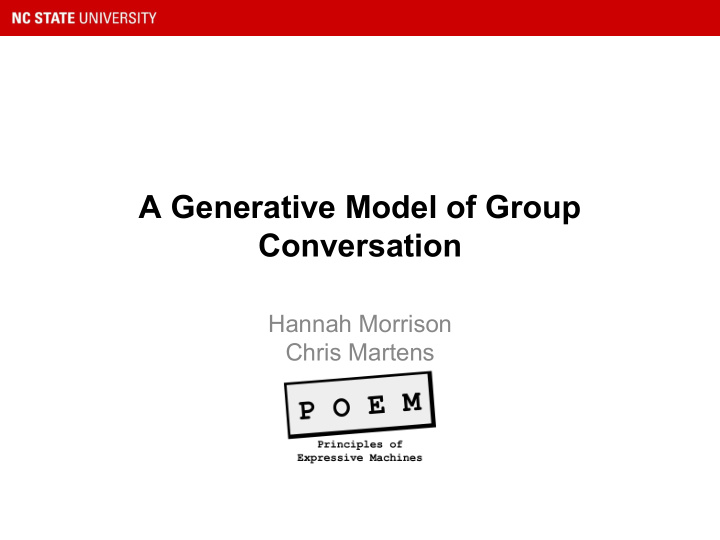



A Generative Model of Group Conversation Hannah Morrison Chris Martens
About Me • Junior at North Carolina State University • Favorite games: Transistor , Hellblade: Senua’s Sacrifice , Life is Strange , Overwatch https://lh3.googleusercontent.com/bv677TeGn5sOGjMud3zSqJBNPec1Ip_ http://www.hellblade.com/new-hellblade-title-poster/ 2w5Y1oN6J9q0pAdLDWAn_F-WezvE0SykrWHiP1v5rYmhhzODwobJUvelL 4V-q=s300
Introduction • Why is character believability important? • Character personality is built through conversation
Introduction Example: Overwatch Overwatch Uprising 000. Digital Image. Blizzard Press Center. Blizzard Entertainment. Web. Reference Kit: Symmetra . Digital image. Play Overwatch . Blizzard Entertainment. Web. "Symmetra/Quotes." Overwatch Wiki . Gamepedia, 21 Apr. 2017. Web. 17 July 2017. "Uprising/Quotes." Overwatch Wiki . Gamepedia, 30 May 2017. Web. 17 July 2017.
Introduction Example: Dragon Age: Inquisition http://dragonage.wikia.com/wiki/Cassandra_Pentaghast/Dialogue http://gamingtrend.com/wp-content/uploads/2014/11/Dragon-Age-Inquisition-Preview-01.jpg
Introduction Problem: hand-authoring conversations Solution: generative conversation models https://www.polygon.com/e3/2017/6/14/15803834/detroit-become-humans-e3-2017-script-david-cage https://www.vg247.com/2015/09/23/until-dawns-script-was-10000-pages-long/ https://gamerant.com/witcher-3-script-length/
The Model Outline: • Approach – Related Work – Overview – Conversation – Agent Personality – Emotion – Belief Change • Example Conversation • Results/Analysis • Future Work
The Model: Related Work • Inspired by Ryan et al., Short and Evans • Based rules on work by Stodgill, Johnson and Johnson, Gibson • Written in Ceptre – Linear-logic based modeling language Richard Evans and Emily Short. 2014. Versu—a simulationist storytelling system. IEEE Transactions on Computational Intelligence and AI in Games 6, 2 (2014), 113–130 James Ryan, Michael Mateas, and Noah Wardrip-Fruin. 2016. A lightweight videogame dialogue manager. Proc. DiGRA–FDG (2016). David R Gibson. 2003. Participation shifts: Order and differentiation in group conversation. Social forces 81, 4 (2003), 1335–1380 David W Johnson and Frank P Johnson. 1991. Joining together: Group theory and group skills. Prentice-Hall, Inc. Ralph M Stogdill. 1959. Individual behavior and group achievement: A theory; the experimental evidence. (1959). Chris Martens. 2015. Ceptre: A language for modeling generative interactive systems. In Eleventh Artificial Intelligence and Interactive Digital Entertainment Conference.
The Model: Overview • “The Model” = Ceptre Program • Conversation topics and characters are hard-coded – may be changed by the author • Characters can have changing opinions and emotions, have personalities • Output: conversational skeletons • No goal-oriented behavior (yet)
The Model: Overview This is Carol. This is Alice. This is Bob.
The Model: Overview Initial State: Current State: Let’s talk about -Alice, Bob, and Carol like -Alice, Bob, and Carol like each other. the weather. each other. -Alice, Bob, and Carol feel content. -Alice, Bob, and Carol feel -Alice has the Participant personality. content. -Bob has the People Pleaser -Alice has the Participant Personality. personality. -Carol has the Contrarian Personality. -Bob has the People -Alice and Carol have a positive opinion Pleaser Personality. of the weather. -Carol has the Contrarian -Bob has a negative opinion of the Rule: Initiate Personality. weather. Conversation -Alice and Bob have a -Current Topic: Weather positive opinion of the Shorthand: weather. State Change: -Carol has a negative -Current Topic: Weather opinion of the weather. (Rule: Initiate -Current Topic: None Conversation)
The Model: Conversation • Rules (mostly) enforce conversational norms and flow – e.g. only one person may speak at a time Example interrupt: if C is the type of person to interrupt someone and C’ is currently speaking then C interrupts C’ and C is currently speaking and C’ feels miffed
The Model: Conversation I think-- I think the weather is horrible! State Change: State Change: -Alice is speaking. -Carol is speaking. (Rule: Begin Speaking) (Rule: Interrupt) -Alice feels miffed. (Rule: Interrupt)
The Model: Personality • Personality Archetypes: Participant, People-Pleaser, Contrarian, Reticent • Rules only accessible to certain personality archetypes Example: agree to please : if C hears C’ say their opinion on a topic and C is a People-Pleaser then C vocalizes agreement with C’
The Model: Personality I agree, Carol. The weather State Change: is too hot. -Bob is speaking. (Rule: Agree to Please)
The Model: Emotion • Rules describe emotional state transitions • Characters can feel encouraged, dejected, miffed, angry, content Example: upset from interruption : if C feels miffed twice then C feels angry
The Model: Emotion I think-- I think the weather is awful! State Change: State Change: -Alice is speaking. -Carol is speaking. (Rule: Begin Speaking) (Rule: Interrupt) -Alice is angry. (Rule: Upset From Interruption)
The Model: Belief Change • Rules depict changing sentiments of the characters • Characters can have a positive, negative, or neutral sentiment regarding a topic Example: negative to neutral opinion : if C has a negative opinion about the current topic and C hears C’ voice a positive opinion about the current topic then C has a neutral opinion about the current topic
The Model: Belief Change I like the Maybe the weather. I think weather isn’t as the weather is bad as I thought. perfect for swimming. State Change: State Change: -Alice is speaking. -Carol has a neutral opinion (Rule: Begin of the weather. Speaking/Finish Speaking) (Rule: Negative to Neutral Opinion)
The Model Outline: • Approach – Related Work – Overview – Conversation – Agent Personality – Emotion – Belief Change • Example Conversation • Results/Analysis • Future Work
The Model: Example Conversation
The Model Outline: • Approach – Related Work – Overview – Conversation – Agent Personality – Emotion – Belief Change • Example Conversation • Results/Analysis • Future Work
The Model: Analysis • Expressive range: range of outcomes the model is capable of generating – Goal: produce a variety of meaningful outcomes • To test: run the program with different combinations of inputs – A few outcomes: not good – Many outcomes: good
The Model: Analysis
Future Work • Add natural-language generation • Add depth to belief change • Add wider range of social interactions
Future Work • Games – Automate non-story-essential conversations • Social Skills Training – Help practice interacting in groups • Combine these areas
Conclusion • Conversations are a fundamental part of narrative and character development, but authoring them is time consuming • We created a generative model of conversation • Our model generates dynamic, diverse representations of conversations between groups of characters • E-mail: hmorris3@ncsu.edu
Recommend
More recommend